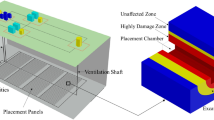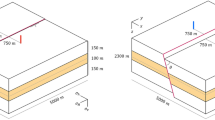Abstract
Coupled hydro-mechanical (HM) processes are significant in geological engineering such as oil and gas extraction, geothermal energy, nuclear waste disposal and for the safety assessment of dam foundations and rock slopes, where the geological media usually consist of fractured rock masses. In this study, we developed a model for the analysis of coupled hydro-mechanical processes in porous rock containing dominant fractures, by using the numerical manifold method (NMM). In the current model, the fractures are regarded as different material domains from surrounding rock, i.e., finite-thickness fracture zones as porous media. Compared with the rock matrix, these fractured porous media are characterized with nonlinear behavior of hydraulic and mechanical properties, involving not only direct (poroelastic) coupling but also indirect (property change) coupling. By combining the potential energy associated with mechanical responses, fluid flow and solid–fluid interactions, a new formulation for direct HM coupling in porous media is established. For indirect coupling associated with fracture opening/closure, we developed a new approach implicitly considering the nonlinear properties by directly assembling the corresponding strain energy. Compared with traditional methods with approximation of the nonlinear constitutive equations, this new formulation achieves a more accurate representation of the nonlinear behavior. We implemented the new model for coupled HM analysis in NMM, which has fixed mathematical grid and accurate integration, and developed a new computer code. We tested the code for direct coupling on two classical poroelastic problems with coarse mesh and compared the results with the analytical solutions, achieving excellent agreement, respectively. Finally, we tested for indirect coupling on models with a single dominant fracture and obtained reasonable results. The current poroelastic NNM model with a continuous finite-thickness fracture zone will be further developed considering thin fractures in a discontinuous approach for a comprehensive model for HM analysis in fractured porous rock masses.





















Similar content being viewed by others
References
An XM, Li LX, Ma GW, Zhang HH (2011) Prediction of rank deficiency in partition of unity-based methods with plane triangular or quadrilateral meshes. Comput Methods Appl Mech Eng 200:665–674
Bandis S, Lunsden AC, Barton NR (1983) Fundamentals of rock joint deformation. Int J Rock Mech Min Sci Geomech Abstr 29:249–268
Biot MA (1941) General theory of three dimensional consolidation. J Appl Phys 12:155–164
Bower KM, Zyvoloski G (1997) A numerical model for thermo-hydro-mechanical coupling in fractured rock. Int J Rock Mech Min Sci Geomech Abstr 34:1201–1211
Chen GQ, Ohnishi Y, Ito T (1998) Development of high-order manifold method. Int J Numer Methods Eng 43:685–712
Duncan JM, Chang CY (1970) Nonlinear analysis of stress– strain in soils. J Soil Mech Found Div ASCE 96(SM5):1629–1653
Goodman RE (1974) The mechanical properties of joints. In: Advances in rock mechanics: proceedings of the third congress of the international society for rock mechanics, pp. 127–140
Goodman RE (1976) Methods of geological engineering in discontinuous rocks. West Publishing, New York
Guvanasen V, Chan T (1995) A new three-dimensional finite-element analysis of hysteresis thermohydromechanical deformation of fractured rock mass with dilatance in fractures. In: Proceedings of the second conference on mechanics of jointed and faulted rocks. Vienna April 10–14, pp. 347–442
Hu M, Wang Y, Rutqvist J (2015) On continuous and discontinuous approaches for modeling groundwater flow in heterogeneous media using the numerical manifold method: model development and comparison. Adv Water Resour 80:17–29
Itasca Consulting Group (2011) UDEC Manual: Universal Distinct Element Code version 5.0 Minneapolis, MN, USA
Itasca Consulting Group (2013) 3DEC (Advanced, Three Dimensional Distinct Element Code), Version 5.0, Minneapolis, MN, USA
Jing LR, Ma Y, Fang ZL (2001) Modeling of fluid flow and solid deformation for fractured rocks with discontinuous deformation analysis (DDA) method. Int J Rock Mech Min Sci 38(3):343–355
Kim Y, Amadei B, Pan E (1999) Modeling the effect of water, excavation sequence and rock reinforcement with discontinuous deformation analysis. Int J Rock Mech Min Sci 36(7):949–970
Kohl T, Hopkirk RJ (1995) The finite element program “FRACTure” for the simulation of hot dry rock reservoir behavior. Geothermics 24:345–359
Ling SD, Ye M (2005) Manifold element method for Biot’s plane consolidation analysis. Chin J Comput Mech 22(3):274–280
Ma GW, An XM, He L (2010) The numerical manifold method: a review. Int J Comput Methods 7(1):1–32
McNamee J, Gibson RE (1960) Plane strain and axially symmetric problems of the consolidation of a semi-infinite clay stratum. Q J Mech Appl Math 13:210–227
Nguyen TS (1996) Description of the computer code FRACON. In: Stephansson O, Jing L, Tsang C-F (eds) Coupled thermo-hydro-mechanical processes of fractured media, vol 79. Elsevier, Amsterdam, pp 539–544 (Developments in Geotechnical Engineering)
Nguyen TS, Selvadurai APS (1995) Coupled thermal-hydrological- mechanical processes in sparsely fractured rock. Int J Rock Mech Min Sci Geomech Abstr 32:465–480
Noorishad J, Ayatollahi MS, Witherspoon PA (1982) Coupled stress and fluid flow analysis of fractured rock. Int J Rock Mech Min Sci 19:185–193
Noorishad J, Tsang CF, Witherspoon PA (1992) Theoretical and field studies of coupled hydromechanical behavior of fractured rock–1. Development and verification of a numerical simulator. Int J Rock Mech Min Sci 29(4):401–409
Ohnishi Y, Kobayashi A (1996) THAMES. In: Stephansson O, Jing L, Tsang C-F (eds) Coupled thermo-hydro-mechanical processes of fractured media, vol 79. Elsevier, Amsterdam, pp 545–549 (Developments in Geotechnical Engineering)
Ohnishi Y, Shibata H, Kobayashi A (1987) Development of finite element code for the analysis of coupled thermo-hydro-mechanical behavior of a saturated-unsaturated medium. In: Tsang C-F (ed) Coupled processes associated with nuclear waste repositories. Academic Press, Orlando, pp 679–696
Pine RJ, Cundall PA (1985) Application of the fluid rock interaction program (FRIP) to the modeling of hot dry rock geothermal energy systems. In: Stephansson O (ed) Proceedings of the international symposium on fundamentals of rock joints. Centek Publishers, Lulea, pp 293–302
Rutqvist J, Stephansson O (2003) The role of hydromechanical coupling in fractured rock engineering. Hydrogeol J 11(1):7–40
Rutqvist J, Noorishad J, Tsang CF (1998) Determination of fracture storativity in hard rocks using high-pressure injection testing. Water Resour Res 34(10):2551–2560
Rutqvist J, Tsang CF, Stephansson O (2000) Uncertainty in the maximum principal stress estimated from hydraulic fracturing measurements due to the presence of the induced fracture. Int J Rock Mech Min Sci 37:107–120
Rutqvist J, Borgesson L, Chijimatsu M, Jing L, Nguyen ST, Noorishad J, Tsang C-F (2001) Thermohydromechanics of partially saturated geological media: governing equations and formulation of four finite element models. Int J Rock Mech Min Sci 38(1):105–127
Shi GH (1992) Manifold method of material analysis. In: Transaction of the 9th army conference on applied mathematics and computing, U.S. Army Research Office
Shi GH (1996) Simplex integration for manifold method, FEM, DDA and analytical analysis. In: Salami MR, Bank D (eds) Discontinuous deformation analysis (DDA) and simulations of discontinuous media. TSI press, Albuquerque, pp 205–262
Silvestre JR, Vargas EA, Vaz LE, Soares AC (2015) Modelling of coupled fluid-mechanical problems in fractured geological media using enriched finite elements. Int J Numer Anal Methods Geomech 39:1104–1140
Swenson DV, DuTeau R, Sprecker T (1997) A coupled model of fluid flow in jointed rock applied to simulation of a hot dry rock reservoir. Int J Rock Mech Min Sci Geomech Abstr 34:308
Wang Y (1995) Seepage flow analysis and seepage-stress coupled analysis of fissured rock masses. Ph.D. Dissertation, Hohai University
Wang HF (2000) Theory of linear poroelasticity. Princeton University Press, Princeton
Wang Y, Su BY, Xu ZY (1998) Coupling analysis of seepage and stress in multi-fractured rock masses. J Hohai Univ 26(2):26–30
Wang Y, Xu ZY, Su BY (1998) Four- freedom complete method for the seepage-stress coupled analysis in fissured rock masses. Hydraul J 7:55–59
Wang Y, Hu M, Zhou Q, Rutqvist J (2014) Energy-work-based numerical manifold seepage analysis with an efficient scheme to locate the phreatic surface. Int J Numer Anal Methods Geomech 38:1633–1650
Witherspoon PA, Wang JSY, Iwai K, Gale JE (1980) Validity of the cubic law for fluid flow in a deformable fracture. Water Resour Res 16:1016–1024
Zhang HW, Zhou L (2006) Numerical manifold method for dynamic nonlinear analysis of saturated porous media. Int J Numer Anal Methods Geomech 30:927–951
Zienkiewicz OC, Qu S, Taylor RL, Nakazawa S (1986) The patch test for mixed formulation. Int J Numer Methods Eng 23:1873–1883
Zienkiewicz OC, Huang MS, Wu SM (1993) A new algorithm for the coupled soil-pore fluid problem. Shock Vib 1(1):3–14
Acknowledgments
The research was supported by the National Natural Science Foundation (No. 51179060) and the Education Ministry Foundation of China (No. 20110094130002) and, in part, by the US Department of Energy to LBNL under contract No. DE-AC02-05CH11231.
Author information
Authors and Affiliations
Corresponding author
Rights and permissions
About this article
Cite this article
Hu, M., Wang, Y. & Rutqvist, J. Fully coupled hydro-mechanical numerical manifold modeling of porous rock with dominant fractures. Acta Geotech. 12, 231–252 (2017). https://doi.org/10.1007/s11440-016-0495-z
Received:
Accepted:
Published:
Issue Date:
DOI: https://doi.org/10.1007/s11440-016-0495-z




